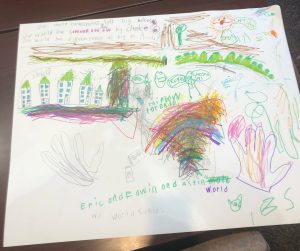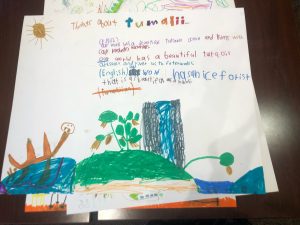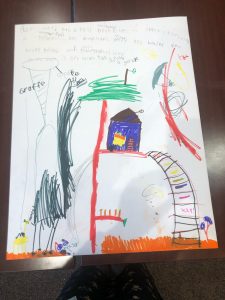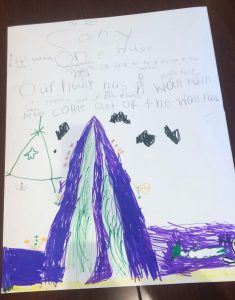Fall SAVY 2022–Playing With Words for Grades 1 & 2
Day 3: November 5
I’m happy I got to meet some of you at the open house this Saturday. Working with your students over the past few weeks as been so rewarding!
For our final class, we focused on persuasive writing and analogies. I introduced persuasive writing with the hamburger model of a paragraph. We talked about what an introduction and conclusion were (the buns of the hamburger) and talked about why providing reasons (the hamburger and its toppings) for our persuasive writing was important. The students filled out several worksheets to practice with the structure of a persuasive paragraph then had the chance to write their own persuasive paragraph about where they think is the bast place to vacation. After the students wrote their own paragraphs, we did a peer review where the students switched paragraphs with a partner and “graded” them against peer review worksheet. I took the time to explain that the purpose of having others looks over our work was to make it better.
After lunch, we shifted to talking about analogies and how they related to the figurative language we talked about in the second week. We also revisited critical reading by filling out a literature web of a poem that contained some figurative language. Because this was our last class, I took the time to review all of the vocabulary words we learned and review our major projects to remind the students of everything they learned.
I saw several of the bigger concepts start to really click with some of your students during this final class and overall review. I asked the students to write down a list of the vocabulary words we discussed throughout our three weeks together, and I would encourage you to go over the words with them to keep these concepts fresh!
Thank you again!
Very best,
Tori Thurmond
Day 2: Saturday, October 29
The focus of this week’s class was imagery and figurative language. To start class, I had the students write about something that changed in the past week to remind them of our focus from the previous week. After their journal time, we jumped right into defining imagery and adjectives. We talked about how descriptive words like adjectives build imagery in writing.
Last week, several of the students mentioned enjoying The Magic Tree House book series, so I pulled an excerpt from one of the books in the series to point out adjectives and descriptive verbs. I then took the class outside to observe different categories of adjectives. The students wrote down words describing what they saw, heard, and felt. When we returned to the classroom, I had the students pick their favorite descriptive words from their notes and place them on posters labeled “See,” “Hear,” and “Feel.” We then talked about how several of the common words could fit into multiple categories. To wrap up our morning activities, we read Many Lucious Lollipops with the intention of identifying descriptors that helped create imagery.
After lunch, we dove into defining figurative language by looking more specifically at similes and metaphors. I read the students three short poems that incorporated the two forms of figurative language before the students filled out a handout where they were asked to determine if a phrase was a simile, metaphor, or a literal phrase.
After practicing our vocabulary words from this week and last, we then read Baloney (Henry P.) to revisit context clues. To finish the day, I had the students work together to create their own language like Jon Scieszka and Lane Smith did when writing Baloney (Henry P.). The students were asked to make a poster with three sentences including three made-up words that could be understood using context clues and illustrations, three adjectives, and one simile or metaphor. To end class, the students were asked to present their posters to the class.
The students impressed me with how they worked together to create a finished product. I feel that the students gained an understanding of figurative language and how to identify descriptors within a work of literature.
Thank you again for allowing me to teach your students, and I look forward to spending another week with them!
Very best,
Tori Thurmond
Day 1: Saturday, October 22
We had a great first day of SAVY! After encouraging the students introduce themselves, we jumped right in to talking about our main course concept: change. We spent the morning defining “change” and categorizing some of the changes that we often experience. Before lunch, we read “Nothing Gold Can Stay” by Robert Frost and identified where change occurred in the poem. The students learned what it means to critically read by breaking down the poem line by line and talking about it as a class.
When the students returned from lunch, we went outside to take field notes. The students were asked to make observations of things in nature that experience change throughout the year and make notes for the second half of our activity. When we returned to the classroom, the students were asked to write a poem like “Nothing Gold Can Stay” or a fictional story incorporating some of the changes they identified outside.
For the last main activity of the day, we read a poem called “Cobbler, Cobbler” to learn about change in language over time and context clues. The students were then asked to re-write the poem in modern-day language. As a recap of the day, we went over our vocabulary words and talked about noticing and understanding change in everyday life and how that can be reflected in language and literature.
We will continue to build on these concepts in our remaining class meetings.
Here’s a list of a few of the vocabulary words we went over Saturday. I encourage you to ask your student to define a few of these words for you and provide examples.
- Literature
- Context Clue
- Critical Reading
- Positive
- Negative
- Change
- Cobbler
- Illustrate
- Unexpected
This class is made up of a bright group of students! I enjoyed getting to work with each one of them and look forward to seeing them again next week.
Very Best,
Tori Thurmond




